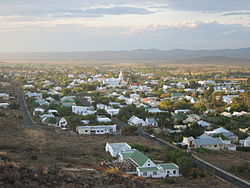Prince Albert, South Africa
|
Prince Albert Prins Albert |
|
|---|---|

View overlooking Prince Albert
|
|
|
|
|
| Coordinates: 33°13′31″S 22°01′48″E / 33.22528°S 22.03000°ECoordinates: 33°13′31″S 22°01′48″E / 33.22528°S 22.03000°E | |
| Country | South Africa |
| Province | Western Cape |
| District | Central Karoo |
| Municipality | Prince Albert |
| Established | 1842 |
| Area | |
| • Total | 37.70 km2 (14.56 sq mi) |
| Population (2011) | |
| • Total | 7,054 |
| • Density | 190/km2 (480/sq mi) |
| Racial makeup (2011) | |
| • Black African | 2.2% |
| • Coloured | 85.7% |
| • Indian/Asian | 0.2% |
| • White | 11.3% |
| • Other | 0.6% |
| First languages (2011) | |
| • Afrikaans | 91.7% |
| • English | 4.7% |
| • Other | 3.6% |
| Postal code (street) | 6930 |
| PO box | 6930 |
| Area code | 023 |
Prince Albert (Afrikaans: Prins Albert), South Africa is a small town in the Western Cape in South Africa. It is located on the southern edge of the Great Karoo, at the foot of the Swartberg mountains.
Prince Albert was founded in 1762 on a farm called Queekvalleij that had been on loan to Zacharias and Dina de Beer since 1762
Originally known as Albertsburg, when it obtained municipal status in 1845 it was renamed Prince Albert in honour of Queen Victoria's consort, Prince Albert of Saxe-Coburg. Prince Albert was historically part of the Cape Colony.
During the latter part of the century, a nugget of gold was discovered on a farm in the area. Due to the fact that a similar occurrence had led to the Gold Rush in the Witwatersrand, this new discovery precipitated a similar population boom. However, the prosperity up North was not to be shared in Prince Albert and the gold mined turned out to be minimal.
Prince Albert became a British garrison during the Second Boer War in 1899. The town was the site of several clashes between the British and the Boers during this period.
Prince Albert has a temperate climate with high temperatures in summer, with an average of 33–35 °C, and 17 °C in the winter months. Winter is mainly sunny with colder temperatures and chilly nights, reaching midwinter minimums of 2 °C, with frost in places and some snow on the nearby Swartberg mountains.
Prince Albert has a small local population, mainly engaged in farming and tourism. The village has many authentic Cape Dutch, Karoo and Victorian buildings, thirteen of which are National Monuments. There are several olive farms and other very large export fruit farms in the area, as well as wine producers, sheep farms and an export mohair trade. Birding, hiking, cycling and stargazing are other pursuits for visitors. The area is well known for its endemic veld plants.
...
Wikipedia



